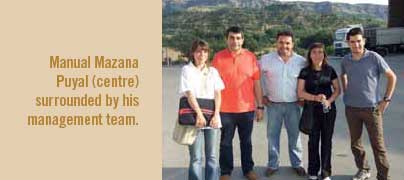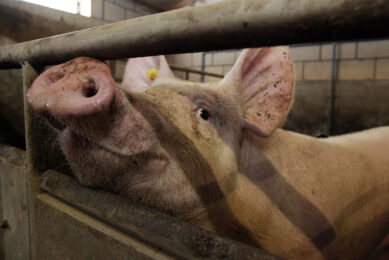Mazana grows from acorn to oak

“From little acorns mighty oaks do grow” is a proverb that speaks for itself. This saying is appropriate when referring to the Mazana feed business in Spain, which started 25 years ago as a small flour milling business and now comprises of a 150,000 tonne feed mill to supply its integrated pig business.
Just outside the town of Huesca, in Aragon, Spain and 90 km south of the French border is a small village dominated by a huge feed mill, literally built on the road side. Across from the mill are a few traditional brick buildings. The connection? The mill – Mazana Piensos Compuestos – or the Mazana feed business, is part of a family concern headed up by director general Manuel Mazana Puyal. The traditional brick buildings were where back in 1986 Puyal’s father started milling grain, brought in by tractors and trailers and which were still in use as recently as 2008.
Instead of tractors and trailers the Mazana business now runs a fleet of 25 articulated trucks, hauling grain and feed. The local farms are on average 20-40 ha in size and the Mazana business supplies them with seed and fertilisers. The business also sells French company Olmix Mistral sanitizer to local farmers.
Half the raw materials are sourced locally. On arrival, trucks are weighed loaded and empty and the content is sampled. NIR technology is used plus the dry matter is checked along with a visual assessment. All the barley used was grown in Huesca province, along with 30% of the wheat. Barley was priced in at €125/tonne, with local farms getting average yields of 3.5 tph. Much is brought in by tractor and trailer by local farmers who take home return loads of pig feed.
Protein sources
With regard to proteins, soy meal is mainly 45-45% crude protein, imported from Argentina and then trucked 200 km from the nearest port. A little full fat soy is used but not much. Fishmeal is also an important protein source but due to an EU ban meat and bone meal and blood meal are not used. Plasma is used in the baby pig diets. Rape/ canola can make up 10% of diets as a substitute for soy, which has become expensive.
Rapeseed has to be imported from France and the former Soviet bloc – 20 years ago quite a lot was grown in Spain but deaths occurred so today none is grown and any supplies obviously have to be imported.
Bran, sorghum and peas also feature in formulations plus sow diets can include up to 8% of homegrown sunflower meal with 2-3% going into grower feeds. Sugar beet pulp (from central and southern Spain) is included in sow rations. “DDGS is generally going into ruminant rations,” Puyal adds. Molasses, lard and soy oil are used to boost energy levels.
Micro-ingredients
There are 12 special silos on site, which contain liquid lysine, liquid methionine, whey, premixes etc. Micronised ingredients are not used. Puyal explains that “these are just used by the specialist creep feed manufacturers, although we buy in special premixes for the creep and pre-starter diets.” Zinc oxide is added at 2.5kg/ tonne (fed for 15 days to control digestive problems) to the pre-starter and starter diets.
Least cost formulations are used allied to “traditional philosophy” regarding ration specifications.
Regarding feed production, the mill produces 26 different feeds, and runs 24hours /day (3x 8 hour shifts) from Monday morning through till 3pm Saturday. Grind –through hammer mills are used, with pre-mixing and ingredients mixed in three tonne batches in a horizontal mixer. Roughly 70% of feed is in meal form, the balance being in pellets of varying sizes to suit the farm feed lines, with the mill producing 30 tph on average.
Pig integrator
Today the mill produces 150,000 tonnes of pig feed annually, which is used to produce 450,000 slaughter pigs, bred, reared and finished on 130 integrated pig farms, 95% of which are in Huesca province. Many farms are very efficient, producing 27 pigs/sow/year. Pietrain genes make up 50% of the slaughter pig, ensuring meaty lean carcasses. Much of the production is exported, however Italy will only import female carcasses. Huesca province has a dearth of slaughter plants and so 85% of the slaughter pigs (105kg live) are hauled 250 km for slaughter in Catalonya. The Mazana business sells the pigs and Puyal is very proud that 90% of pig prices are agreed by a handshake – a rarity in most other countries in 2010. Producers were just in profit (July 2010) but generally pig prices drop once the tourist season finishes at the end of the summer.
Join 26,000+ subscribers
Subscribe to our newsletter to stay updated about all the need-to-know content in the feed sector, three times a week. Beheer
Beheer









 WP Admin
WP Admin  Bewerk bericht
Bewerk bericht